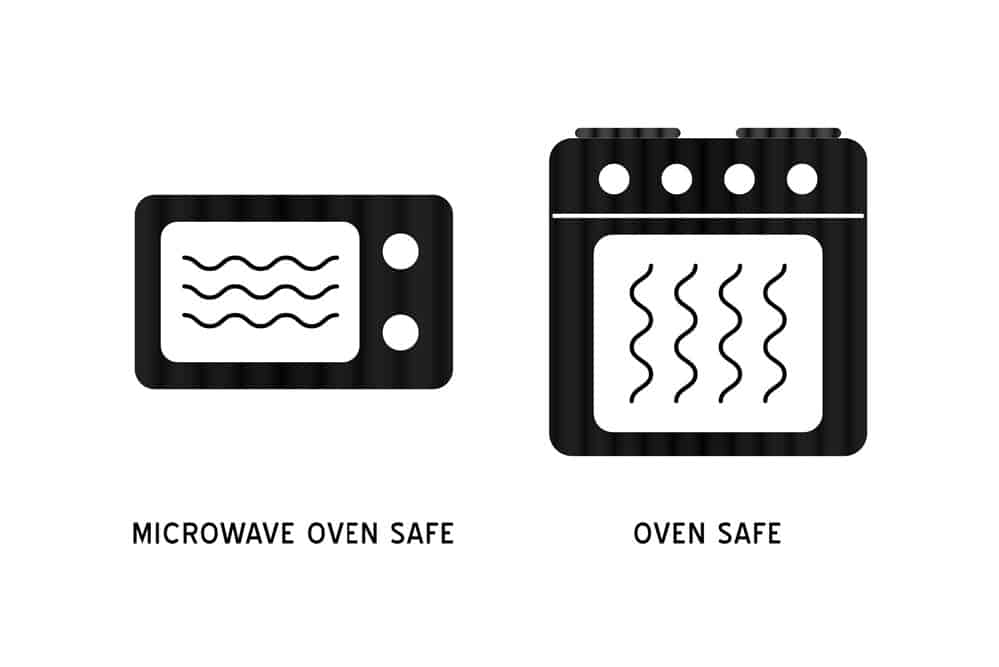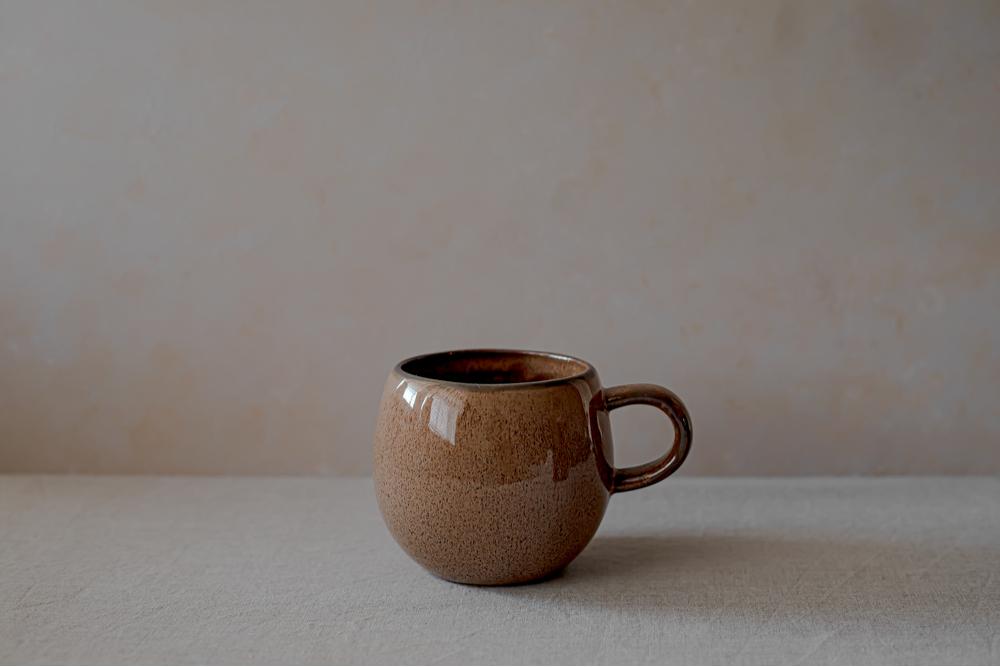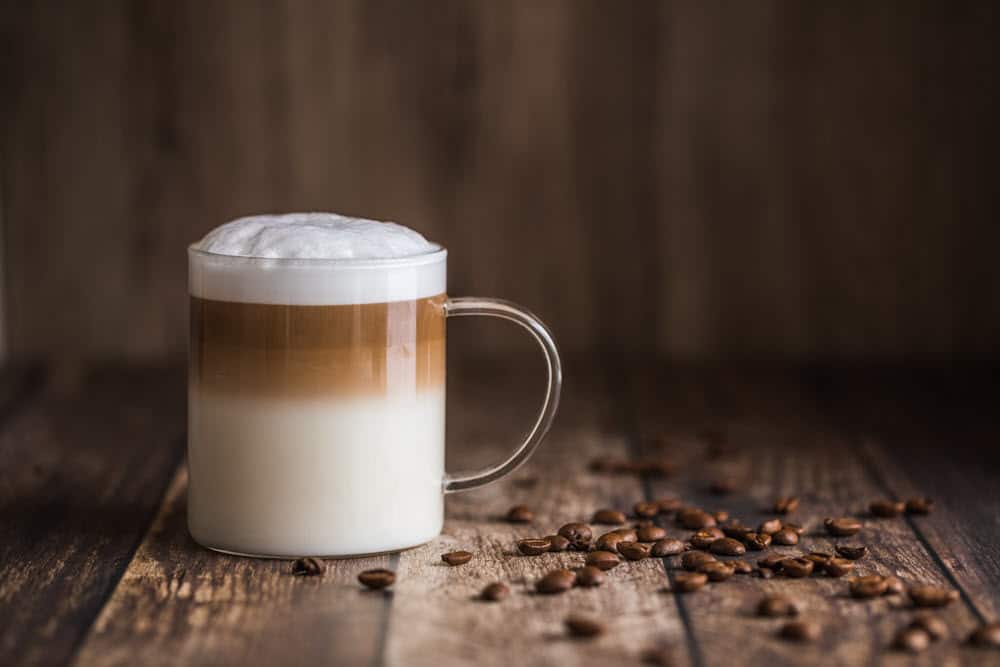There is nothing more comforting than settling in with something warm in a favorite mug. Coffee, tea, cocoa, or cider are the perfect match for a mug. Soups and stews are also enjoyed in a creative and fun way when presented in a mug.
Frequently, the warm ingredients are poured into a room temperature mug. There is usually not a second thought about the integrity of any given mug. But should this always be the case?
However, can you put a mug in the oven? Before you start any recipe or begin any craft, review the dos and don’ts of putting a mug in the oven.
There are a few easy ways to understand if a mug is oven safe. The easiest indication is an oven-safe or microwave-safe symbol. These are usually printed on the bottom of a mug, especially if the piece was manufactured before 1970.

Look for oven safe inidicators like those shown above to know if a mug is oven safe
An oven safe coffee mug may feature a symbol that looks like a crude oven, illustrated by a box with vertical wavy lines inside. The microwave-safe symbol is similar and may appear next to the oven symbol. Microwave safe pieces are labeled with a box complete with horizontal wavy lines.
Mugs range widely in composition. This greatly impacts their ability to survive the conditions of an oven. While many mugs clearly print the substance a mug is made from, and if it is oven safe, some manufacturers do not.
Before inserting your coffee mug into the oven, analyze what and how it was made. Mugs are commonly made from:
Stoneware mugs are very successful in the oven or microwave. This is a common material for a coffee mug and can look like a rough, hand-thrown mug or a mass-produced product. Stoneware mugs are easily identified by a shiny glaze and thick, heavy presence with a rough exterior texture.
This type of mug is the only material that is reliably always oven-safe. Because stoneware is made of clay solidified in high heat, it is considered a form of ceramic. A ceramic mug can easily withstand the temperature of an oven or microwave, much lower than a ceramic firing kiln. A mug made of stoneware should almost certainly be a microwave safe mug as well.

Stoneware mugs are usually quite oven safe
Not only are stoneware mugs safe to use in an oven, but it is also recommended! Small scale baking works well in a stoneware coffee mug, due to the ceramic’s superior heat distribution. In addition to evenly baked desserts, stoneware is naturally nonstick for a low-maintenance clean-up.
Creation of Stoneware Mugs That are Fired At Extremely High Temperatures
While an earthenware mug may appear very similar to stoneware, these mugs are not oven safe. Earthenware is fired to a much lower temperature than stoneware, making it much more fragile. This means your earthenware coffee mug would likely not survive the very high temperatures of a microwave or oven.
You can tell if your mug is earthenware if it is painted, instead of glazed. A painted mug shouldn't go in the oven. Any sort of paint - including acrylic paint - is a warning sign that your coffee mug should stay far away from your oven.
Earthenware is the most common material for mugs as it is much more inexpensive. Mugs made of earthenware are painted, instead of glazed. These mugs also chip or shatter much more easily.
If you’re still not sure if your coffee cup is an earthenware or stoneware mug, consider what you think would be underneath the mug’s exterior if it was chipped. Would a chip reveal a smooth, white clay surface or the same color as the unglazed areas of the mug? Earthenware is the former.
As you may assume, bone china is too delicate for an oven. If the mug somehow survives the extreme heat of an oven, as soon as you transition the bone china mug out of that hot environment, it will most likely shatter.
Bone china is too dainty for the harsh conditions of an oven, microwave, dishwasher, or most other modern convenience appliances. These small ceramic mugs often have intricate designs and small, delicate handles. Transferring warm liquids to a bone china vessel is the best bet.
Similar to bone china, porcelain is best kept out of the extreme environment found in a microwave or oven. porcelain mug may be the perfect fit for your oven-based mug craft, it, unfortunately, may not survive.
Thermal shock is the name for the phenomenon where mugs, plates, cookware, or other items shatter when exposed to significant swings in temperature. Porcelain is quite susceptible to thermal shock, as well as other materials on this list.

While porcelain bakweare is oven safe, you probably shouldn’t trust that your porcelain coffee cup will survive a stay in the oven
Metal is a tremendously resilient material and is well-suited to the conditions of an oven. Metal mugs are often packed into camping gear as a versatile vessel in the great outdoors. Drinking from a stainless steel mug is a unique mouth experience and may not be for everyone.
While metal is extremely oven-safe, there are some additional considerations to using this material. A metal mug transferred from the oven will be extremely hot. Metal conducts heat very efficiently and must be handled with extreme care when taking it out of the oven.
While many of these oven-safe materials can also be considered microwave-safe mugs, that is absolutely not the case for metal. In fact, microwaving metal will at the very least destroy the mug and its contents and most likely the microwave. Fires can ignite from microwaving metal.
If your metal mug has a nonstick surface, it is not recommended for oven use. Make sure your mug does not have any plastic details before inserting it into an oven because the plastic will melt.
Speaking of plastic, never ever put anything acrylic or plastic into an oven. Plastic mugs will melt within the high temperatures of these appliances. This includes plastic details on mugs made of other materials like the plastic grips on the side of travel mugs.
Melting plastic will completely ruin the mug in question and whatever contents were inside. Even if the mug is not destroyed, components of the plastic would have leaked into your food product under an oven’s high temperatures. This is contaminated food and is no longer safe to eat.
You have probably seen those devastating photos of people who have accidentally placed plastic mugs in the oven. Plastic is a very difficult and cumbersome material to clean from the inside of an oven, not to mention the toxic chemicals released into the air from melted plastic.
Enamel mugs are able to withstand high temperatures - as the enamel mug itself is fired at extremely high temps to fuse metal to porcelain.
Glass is one of the trickier mug materials on this list because ordinary folks can easily get the wrong idea. One of the most iconic cookware brands is Pyrex, known for its glassware that easily transitions to the oven. Pyrex is a century old and trusted brand of glass kitchenware, and a glass mug made of Pyrex can survive in the oven as long as temperatures don’t get too hot. Even Pyrex has trouble withstanding temperatures that get too hot. For example, you should never broil with Pyrex bakeware.
However, Pyrex is the exception to the rule. A glass mug may not survive a trip to the oven. The vast majority of glass has not been designed to survive the prolonged high temperatures of an oven or temperature fluctuations.

Most glass mugs aren’t oven safe
The most hazardous aspect of placing a mug in the oven is the risk of shattering. Like porcelain or bone china, glass can surrender to the effects of thermal shock. Glass does not enjoy extreme swings in temperature and may not survive the transition from the oven to countertop.
A DIY Sharpie Mug is a mug that is decorated with a Sharpie. You will have to make sure that the mug you choose to decorate is of a material that can withstand high oven temperatures as putting the mug in the oven is how the ink from the Sharpie can set.
The duration that a coffee mug can stay in the oven will depend entirely on the type of material that it’s made from. As discussed above, materials like plastic, earthenware, bone china, and porcelain are often too fragile to be in the oven at all. Plastic is even toxic so best to avoid any heat there.
However, materials like stoneware and metal can stay in the oven indefinitely. That is, as long as your home oven isn’t capable of reaching kiln levels of heat. If that’s not the case, you should be fine to try out some mug recipes and crafts.
Now that you know if your mug can survive an oven, it’s time to dig into some adorable mug cake recipes! These delicious and easy desserts are great for everyone, as these can even be made in a microwave.
It’s not only simple desserts that bloom when you combine a mug and a microwave or an oven. Simple breakfasts for families on the go are another great option now that you know all about safely using mugs in the oven.
Mug recipes are a great addition to a college student’s dorm room cooking repertoire. Pack sweet or savory ingredients into a metal mug for a slow-cooking breakfast over the campfire. These creative recipes are a fun and versatile way to use your favorite oven-safe mugs.
Now that you have some go-to recipes, you can take your oven mug game to the next level. Consider making a cute gift for a college graduate, favorite teacher, or as a charming and customized Grandparent’s Day present.
Cricut manufactures machines filled with downloadable designs you can print and cut out for monogrammed or personalized items. These designs are printed on a heat transfer sheet and applied via a clothing iron, microwave, oven, or proprietary heat press from the company.
Cricut infusible ink is a new product claiming to offer a more effortless and even longer-lasting transfer process. As the name suggests, this product makes the design one with the surface, fusing itself together. Before, heat transfers would lie on top of the fabric and crack over time.
Yes, enamel mugs are safe for oven use. The process of creating enamel involves the blending of metal and porcelain at extremely high temperatures - making enamel mugs able to withstand the heat from your oven.
The best way to tell if a mug is oven safe is to look for an oven safe symbol on the bottom of the mug. The symbol looks like an oven with wavy lines as shown in the image near the beginning of this article.
To know for sure, look for the oven safe symbol which is usually located on the bottom of your mug or contact the product manufacturer. Stoneware and enamelware mugs are created at extremely high temps making them generally oven safe. Some metal mugs are safe. Keep mugs made of china, porcelain, and earthenware away from your oven - and never put anything made of plastic in your oven.
